 |
||
|
||
| ||
Like most people neither wear designer clothes nor live in villas, most users cannot afford expensive powerful graphics cards like GeForce 8800GTX or RADEON HD 3870 X2 and choose cheaper solutions instead. So, this time we are going to review three Mid-End graphics cards of the $100-$180 price range and a more expensive HD 3870. All our contenders today are based on AMD (ATI) RADEON GPUs. At the same time, our readers will get to know not only production-line HD 3850/3870 cards, but also the HD 3650. The latter card is essentially the RADEON 2600 PRO/XT. Everything is the same: architecture (120 streaming processors, 128-bit bus), similar design. And its frequencies are in between those of the 2600 PRO and the 2600 XT. That is the HD 3650 is actually a hybrid of the 2600 PRO and the 2600 XT. Why launch this product and give it a new name? The fact is, the RV630 core, used in the RADEON 2600 cards, is manufactured by the 65-nm fabrication process. AMD wanted to squeeze maximum performance from this product, so it operated at very high frequencies and dissipated much heat. Having manufactured the RV635-based counterpart by the 55-nm fabrication process, AMD kills two birds with one stone: it reduces manufacturing costs of such GPUs and heat dissipation, preserving the operating frequency in between the 2600 PRO (600 MHz) and the 2600 XT (800 MHz), at about 725 MHz. If these are only domestic transformations in AMD that have to do with their requirements and needs, why do they offer the old product as a new card? Because no marketing department will miss an opportunity to advertise an old product, if there is an excuse—an updated GPU. We've already seen such methods. So users shouldn't be surprised. Thus, all our readers must understand that the RADEON 3650 is a cross between the RADEON 2600 PRO and the RADEON 2600 XT in its performance. There are no other differences. We'll test this assumption below. Graphics Cards
The 3870 cards from HIS and the 3850 cards from MSI are copies of the reference design, we have nothing to add here. We've already examined such cards in our baseline review. These products differ from the reference design only in frequencies and in the cooling system installed on HIS cards. What concerns all new cards of the 3650 family, they are also of the reference design, which is slightly different from the older 2600 PRO cards. However, these differences have to do only with memory chips rotated by 90B° and some minor changes in the power unit. All cards have TV-Out with a unique jack. You will need a special bundled adapter to output video to a TV-set via S-Video or RCA. You can read about the TV-Out in more detail here. Analog monitors with d-Sub (VGA) interface are plugged to the cards with special DVI-to-d-Sub adapters. The bundle also includes DVI-to-HDMI adapters (these graphics cards support video/audio transfer to HDMI receivers), so there should be no problems with such monitors. Maximum resolutions and frequencies:
What concerns MPEG2 playback features (DVD-Video), we analyzed this issue in 2002. Little has changed since that time. CPU load during video playback on modern graphics cards does not exceed 25%. What concerns HDTV, a review is available here. All 38xx cards require additional power supply, so each card is bundled with an adapter from molex to 6-pin, even though all modern PSUs are equipped with these cables. Now about the cooling systems. HIS IceQ III RADEON HD 3870 Turbo 512MB PCI-E and HIS IceQ RADEON HD 3650 Turbo 512MB PCI-E are equipped with the well-known coolers from Arctic Cooling. We've examined them in this review. I can only add that they are the most efficient cooling systems of all we've ever seen. The MSI card comes with the standard cooler, we've also examined it here. It's an efficient and noiseless cooler, but you should monitor its fan speed (it may be too low sometimes, and the card may grow very hot). We monitored temperatures using RivaTuner (written by A.Nikolaychuk AKA Unwinder). Here are the results: HIS IceQ III RADEON HD 3870 Turbo 512MB PCI-E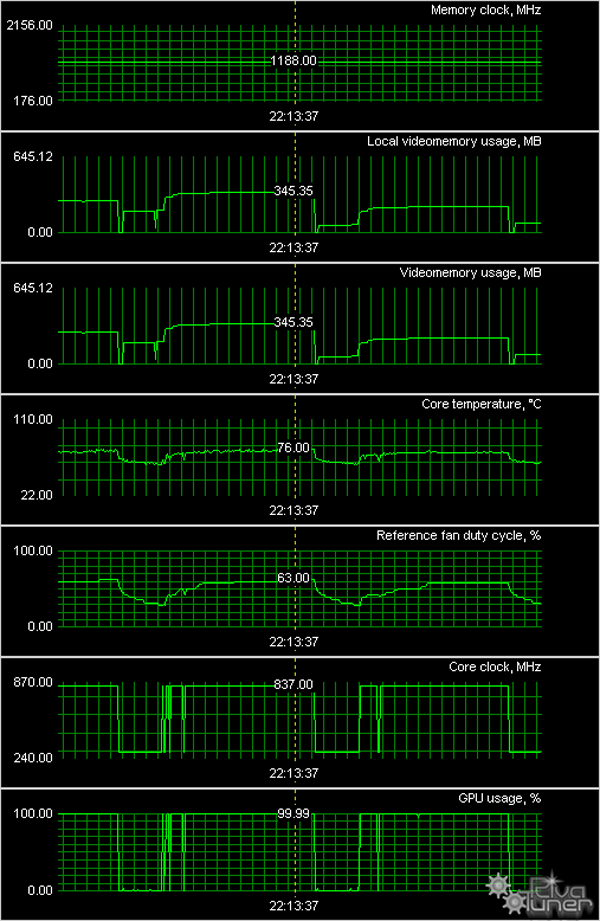 HIS IceQ RADEON HD 3650 Turbo 512MB PCI-E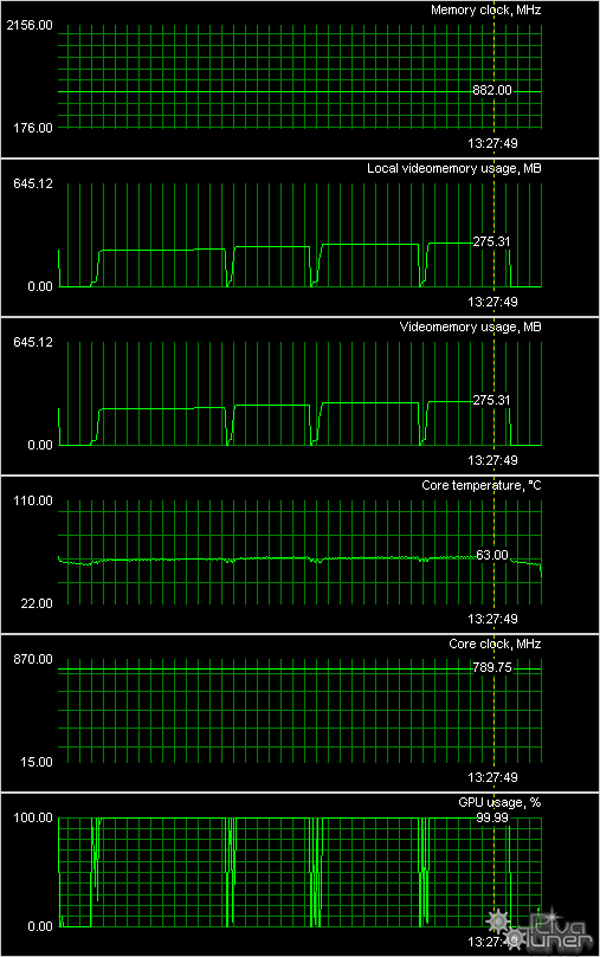 PowerColor RADEON HD 3650 Extreme 512MB PCI-E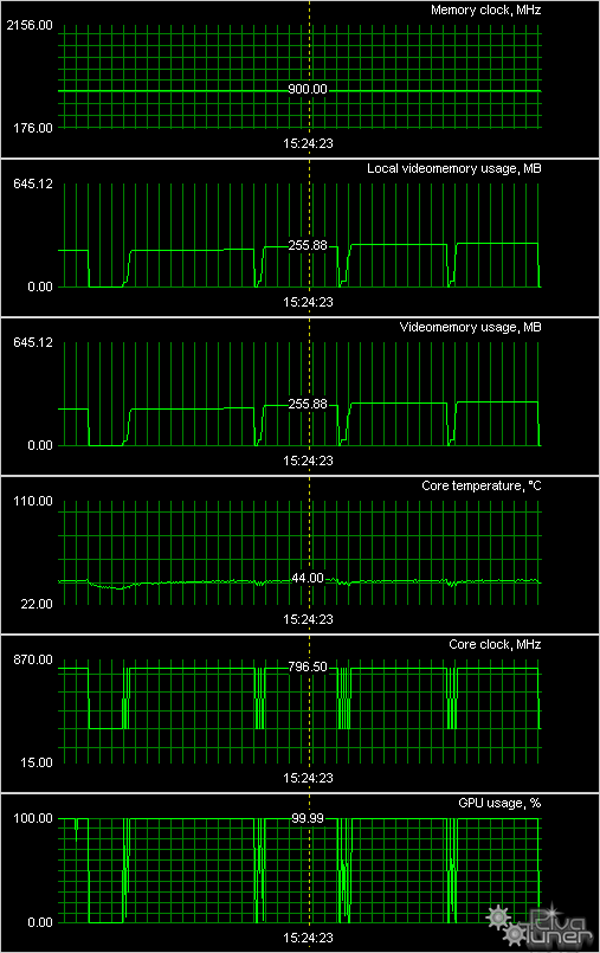 Reference ATI RADEON HD 3650 256MB PCI-E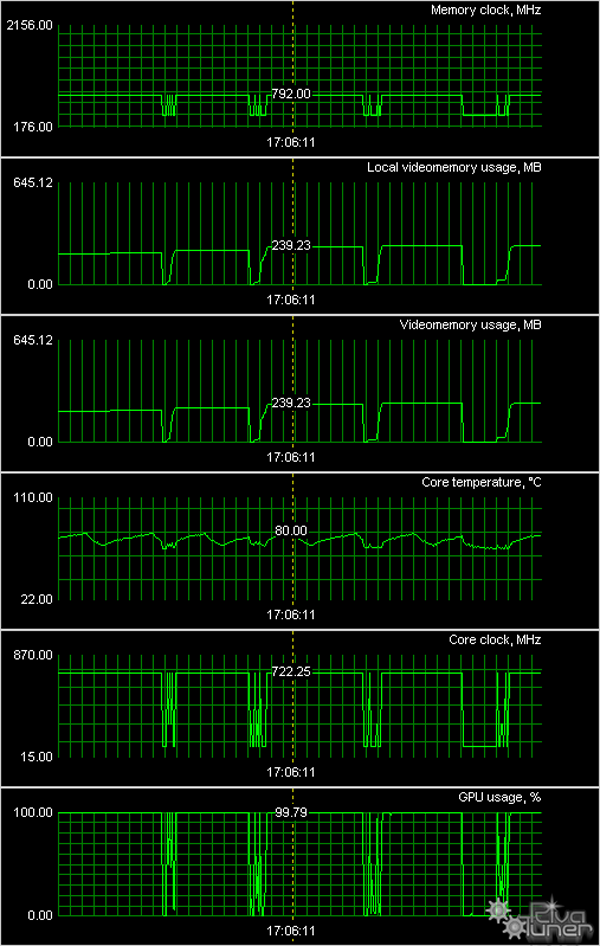 MSI RADEON HD 3850 OC 256MB PCI-E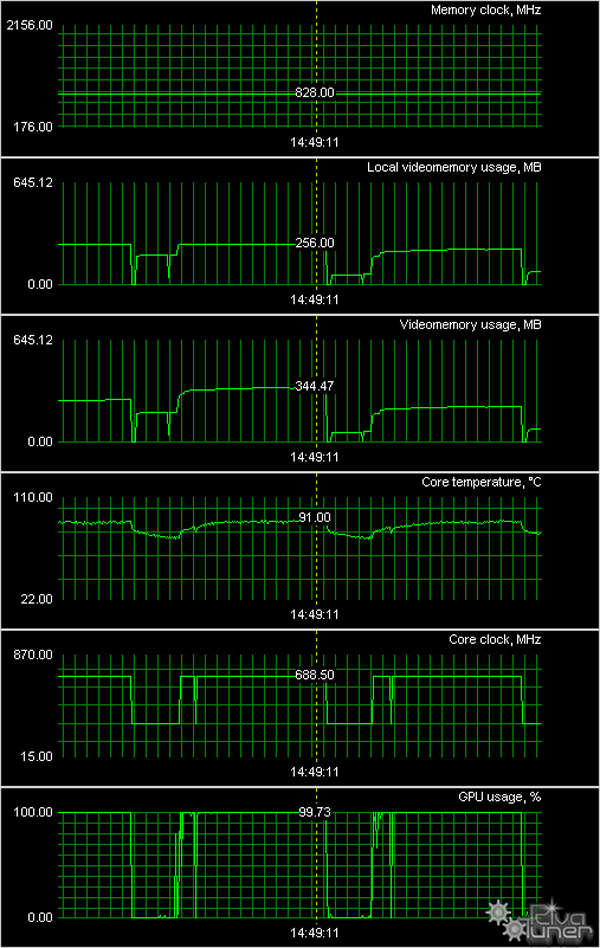
We can see that the cooling system from Arctic Cooling, installed on HIS cards, copes well with its task and remains noiseless. The MSI product is equipped with a reference cooler, so I have nothing new to add, you should consult this review. The core frequency is not raised much, so there are practically no differences in operating temperatures. However, the reference cooler on the 3650 card demonstrates the worst results. It was to be expected from such a device. On the contrary, the cooler from PowerColor demonstrates excellent efficiency, even though the card operates at the increased frequencies. The reference card ATI RADEON HD 3650 was shipped to our testlab as OEM, without its package and bundle. The other cards were bundled with a User Manual, CD with drivers and utilities, a DVI-to-VGA adapter, a DVI-to-HMDI adapter, a component output adapter (TV-Out), and a Steam coupon. That's a basic bundle. And now let's see what other accessories are added by each vendor. BundlesBoxesInstallation and DriversTestbed configuration:
BenchmarksWe used the following benchmarks:
Performance of graphics cardsIf you have a decent understanding of 3D graphics, you may draw your own conclusions for the diagrams below. However, if you are interested in our comments on test results, you may read them after each test. Anything that is important to beginners and those who are new to the world of video cards will be explained in detail in the comments. First of all, you should look through our reference materials on modern graphics cards and their GPUs. Be sure to note the operating frequencies, support for modern technologies (shaders), as well as the pipeline architecture. ATI RADEON X1300-1600-1800-1900 Reference If you have just begun realizing how large the selection to choose a graphics card is, don't worry, our 3D Graphics section offers articles about 3D basics (you will still have to understand them—when you run a game and open its options, you'll see such notions as textures, lighting, etc.) as well as new product reviews. We also publish monthly i3DSpeed that sums up all comparisons of graphics cards for various price ranges. Thirdly, have a look at the test results. We are not going to analyze each test in this article, primarily because for us it makes sense to draw a general bottom line in the end. We will, however, make sure that we make our readers aware of anything unusual. S.T.A.L.K.E.R.Charts: S.T.A.L.K.E.R.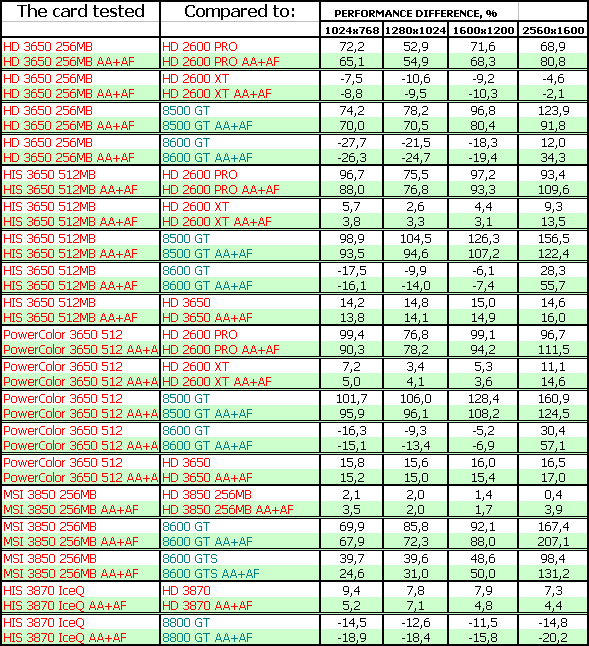 CRYSIS, Rescue, DX9, HighCharts: CRYSIS, Rescue, DX9, High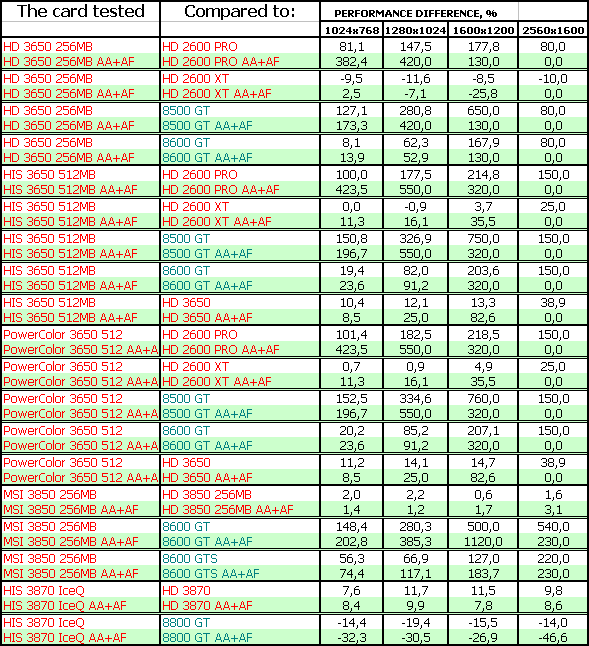 CRYSIS, Harbor, DX9, HighCharts: CRYSIS, Harbor, DX9, High CRYSIS, Rescue, DX10, Very HighCharts: CRYSIS, Rescue, DX10, Very High CRYSIS, Harbor, DX10, Very HighCharts: CRYSIS, Harbor, DX10, Very High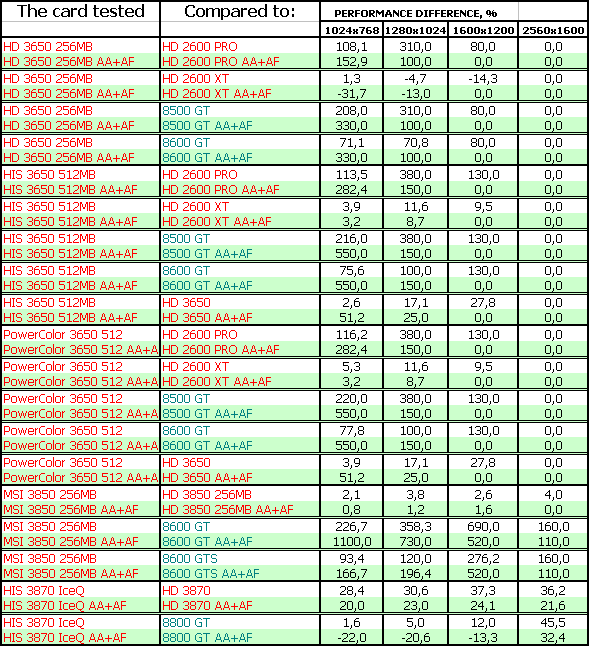 Call Of JuarezCharts: CoJ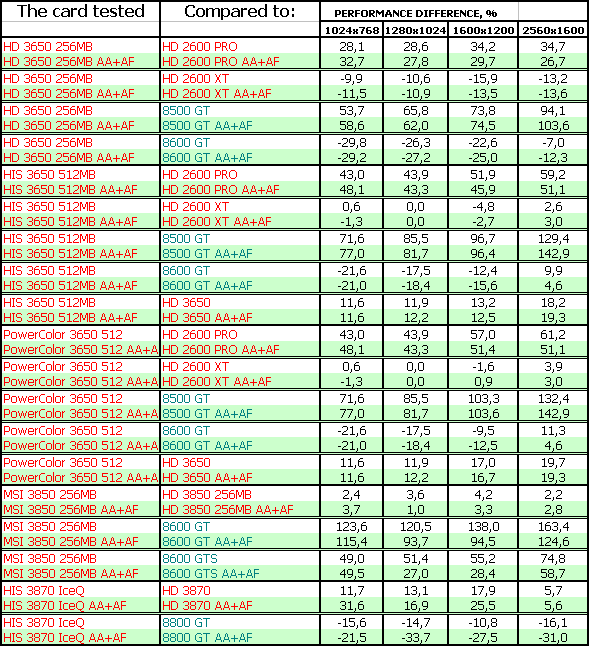 Company Of HeroesCharts: CoH 3DMark05: MARKSCharts: 3DMark05 MARKS 3DMark06: SHADER 2.0 MARKSCharts: 3DMark06 SM2.0 MARKS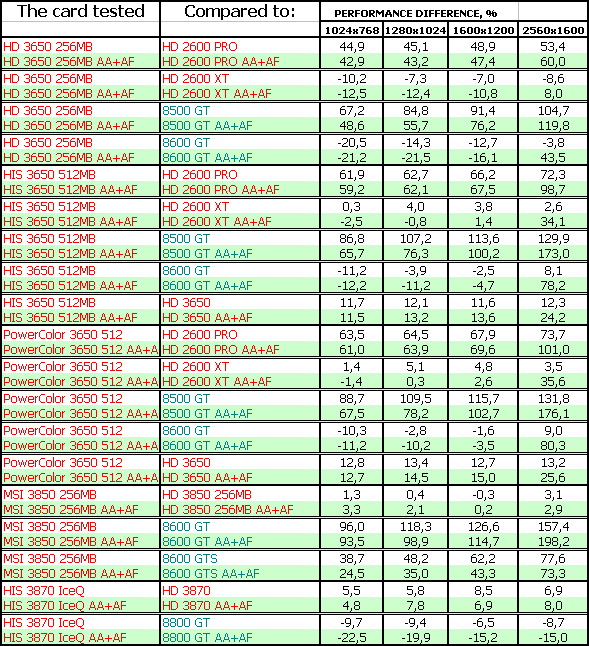 3DMark06: SHADER 3.0 MARKSCharts: 3DMark06 SM3.0 MARKS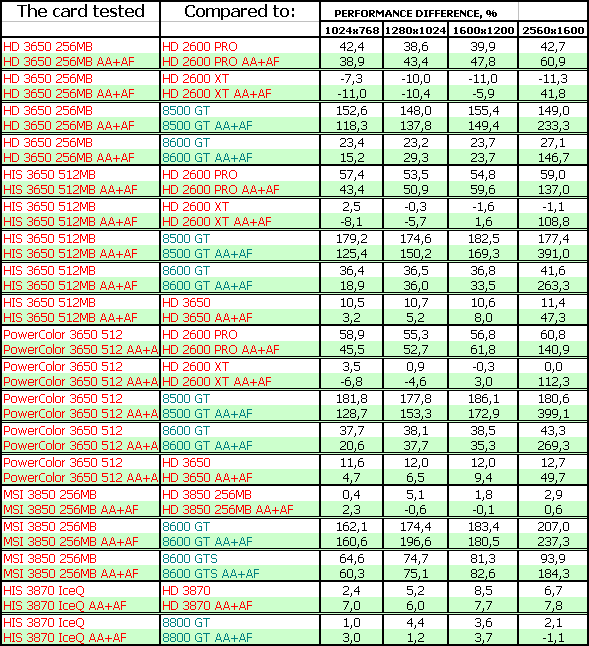 ConclusionsThe RADEON HD 3650 expectedly performs like the RADEON HD 2600 XT, being outperformed by the latter strictly proportional to the difference in operating frequencies. Unlike the 2600 cards, the 3650 cards now support DirectX 10.1. This feature will be praised by marketing specialists to the skies, but it will bring little to end users, because there are no such games so far. Besides, you will have to disable lots of effects to play the latest games on such cards (have a look at CRYSIS results). That is, when you buy such a card, you should not think that you can enable all bells and whistles in the latest games and play them at acceptable speed. Thus, I've proved my initial thesis that the 3650 is essentially identical to the 2600 PRO/XT. Do not get carried away with the numeral 3 in the name of the card. It's just a cunning trick, which stands for a new fabrication process, DX10.1, and improved AVIVO (we haven't tested it yet). But we should point out one important detail: price. It will be lower than for the RADEON HD 2600 cards. In fact, the 3650 will replace these products (the 2600 family will be discontinued). It will be about 100 USD, may be a tad higher. I want to draw your attention to 512 MB of video memory used in these cards. This memory volume will soon become a standard even for such cards, which performance is sufficient in modern games only in low resolutions. That will be the minimum size. Cards with 256 MB of memory will become a thing of the past, just like 128 MB products. HIS IceQ RADEON HD 3650 Turbo 512MB PCI-E is an improved modification of the 3650 (in frequencies and in its cooling system). It's a good choice, if the price is adequate. And you shouldn't forget about the two-slot cooling system. HIS IceQ III RADEON HD 3870 Turbo 512MB PCI-E is actually the best 3870 card of all. It's a tad inferior to the 8800GT, so it must be cheaper. If this condition is true, it will be the best choice (but we should wait for the GeForce 9600, which may shake positions of the 3870 cards). If the 3870 cards have the same prices or are more expensive than the GeForce 8800 GT, the latter will be more preferable. MSI RADEON HD 3850 OC 256MB PCI-E is the standard reference card, it's just slightly overclocked. It offers no special features and comes with a modest bundle. So you just compare the prices and choose a card. The other conclusions on the 3850 have been drawn already. PowerColor RADEON HD 3650 Extreme 512MB PCI-E is currently the best 3650 product. Its increased frequencies yield performance on a par with the 2600 XT, and it's equipped with a highly efficient cooler. And another thing that we are not tired to repeat from article to article. Having decided to choose a graphics card by yourself, you have to realize you're to change one of the fundamental PC parts, which might require additional tuning to improve performance or enable some qualitative features. This is not a finished product, but a component part. So, you must understand that in order to get the most from a new graphics card, you will have to acquire some basic knowledge of 3D graphics and graphics in general. If you are not ready for this, you should not perform upgrades by yourself. In this case it would be better to purchase a ready chassis with preset software (along with vendor's technical support,) or a gaming console that doesn't require any adjustments. To find more information regarding the current graphics card market and the performance of various cards, feel free to read our monthly special i3DSpeed. HIS IceQ III RADEON HD 3870 Turbo 512MB PCI-E, PowerColor RADEON HD 3650 Extreme 512MB PCI-E, HIS IceQ RADEON HD 3650 Turbo 512MB PCI-E get the Original Design award:  HIS IceQ III RADEON HD 3870 Turbo 512MB PCI-E gets the Excellent Package award:  We express gratitude to
HIS Russia and Vitaly Milov, PowerColor Russia and Ilya Ostrovsky, MSI Russia and Maria Kislyakova, AMD Russia and Nikolay Radovsky for the provided graphics cards PSU kindly provided by TAGAN, Monitor kindly provided by NVIDIA Andrey Vorobiev (anvakams@ixbt.com) March 10, 2008 Write a comment below. No registration needed!
|
Platform · Video · Multimedia · Mobile · Other || About us & Privacy policy · Twitter · Facebook Copyright © Byrds Research & Publishing, Ltd., 1997–2011. All rights reserved. | ||||||||||||||||||||||||||||||||||||||||||||||||||||||||||||||||||||||||||||||||||||||